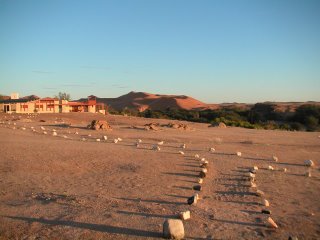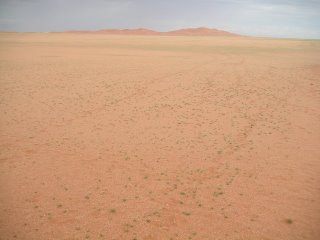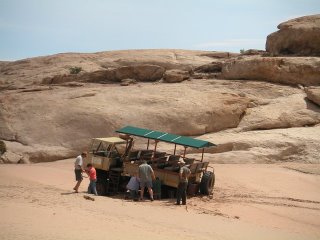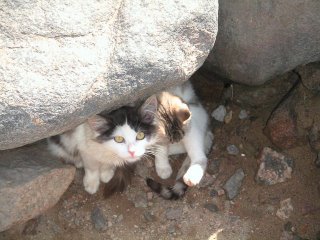Journey to the Gobabeb Research Centre
I took Friday off from work so that I could travel with colleagues to the Gobabeb Research Centre in the middle of the Namib-Naucluft. The Namib desert is considered to be the oldest desert in the world, having endured arid or semi-arid conditions for at least 80 million years. Its aridity is caused by the descent of dry air cooled by the cold Benguela current along the coast. It has less than 10 mm (0.4 inches) of rain annually and is almost completely barren. (Wiki)
On route to the desert we took one of the back roads. These roads require a 4×4 vehicle but are well worth it. I traveled with Barbara and Uli from the Polytechnic. They invited me along to attend their annual Rotary Club meeting which this year was held at the research station. Gobabeb is not really a place that tourists are allowed to visit openly so it was a great opportunity for me to experience the desert.
En route this valley opened up to us. It was a really amazing sight to see. I don’t think these pictures really captured the magnitude of this outlook. I could easily have stopped and spent the remainder of the weekend right here.


You would almost expect a dinosaur to stoll through this terrain. 😉


Going to the desert this year is said to be a very unique experience as this year there have been unheard of amounts of rain in Namibia. For the first time in ages the desert is covered with growth. It was amazing to see the desert like this. Being as flat as it is you could see for miles. It was covered in only one type of growth that resembled a wheat plant that was a vibrant greenish-white. It looked as though you could lie down and take a wonderful nap in the field, but actually the ground underneath is very rugged and rocky.


Here we see the desert research station main building in the middle left. This was the view from our cabin. In the background you can see the massive red sands of the Namiib dunes. between the station and the dunes you’ll see a stretch of green which is actualy the Kuiseb river which flows frequently in the rainy season. It is the most fertile area in desert and splits the rugged rocky desert and the fine sandy dunes like a knife.


Currently inside the desert you can actually see some growth forming. In some areas you would think you were on a golf course. The desert researchers actually say that it is a fairly good thing for the desert to get this once and a while. I just hope that the climate has not changed so much that this desert’s life may soon be ending.


One of the few regular plants that lives in the desert. The name has escaped me. I managed to get a close up of the flower of this cactus being harvested by a desert beetle.


Another sign of growth in the rough desert climate. It sure is beautiful contrast, but is it natural?


The classic Namib Desert shot. Just do a google image search to see about 30 variations on it. Unfortunatly this one was taken from the back of a moving vehicle so there is visible camera shake.


Abandon ship! On the return trip we drove through the Kuiseb river bed. It looked dry for the most part. We rolled over a low area of the river where some water had collected underneath. Really no one could have guessed this happening. I was the first off the truck and when my feet hit the ground it was like landing on the skin on top of pudding. The ground was dry on top but entirely liquid underneath. It wobbled but I did not fall through. Really it most resembled walking on thin rubbery ice.


Getting stuck in the mud gave me the opportunity to get some fantastic ground level shots from the river bed. The rock formations were absolutely incredible here. Does this resemble a giant set of toes?


This is my new found friend Jack Daniels from Scotland (No seriously that’s his name and he IS from Scotland!) Jack works part time post retirement for the St. Andrews University in Scotland which is one of the oldest Universities in the world founded in 1413! Jack is about 10 years old at heart and a wealth of information. Jack has found another soft spot in the river and at this point is sinking fast!


Here you can really see how the sand dunes are seperated by the fertile area of the Kuiseb river with the rocky moon landscape in the background. 

About 500 metres down the road from getting stuck the first time we found another sink hole. This second time became more serious as we were at this point out of water, miles from base camp, and had the sun beating down on us with very little shade. We had elderly people with us, one autistic boy and one very young boy. The situation went from funny to scary very quickly and the more susceptable of the group began walking back. When we finally freed ourselves from this second time getting stuck we found them not 50 metres up the road suffering from near heat exhastion.

Thankfully we all made it back to base camp without getting stuck a third time. 
On Saturday evening we set off to enjoy the sunset from the top of the dunes. These beautiful rock formations provided scenery for the trek.


The wonderful formations of the Namib dunes really stand out in the sunset. 

At the top bathed in sunlight we had a lesson on the formation of the dunes over millions of years. It was so quiet at the top less the soft sound of the wind on the sand. 

On Saturday evening we went hunting for scorpions. Did you know that nearly all scorpions glow under ultraviolet light? No one really knows why this is the case, but its likely something in their blood. We set off with a battery powered black light and I used my flash to capture this little fella. 

On Sunday we could not resist popping over to the coast for lunch at the Tug Restaurant. After all in this land of contrast you can go from one of the driest places on earth to the Atlantic Ocean in under an hour. The Tug is built inside a landlocked tug boat and has some of the most wonderful seafood in the country.


The beach was pretty much empty on this day but I did find these little beach bums perched under a rock. 

Like this:
Like Loading...
Michael Paskevicius
Share post:
Journey to the Gobabeb Research Centre
I took Friday off from work so that I could travel with colleagues to the Gobabeb Research Centre in the middle of the Namib-Naucluft. The Namib desert is considered to be the oldest desert in the world, having endured arid or semi-arid conditions for at least 80 million years. Its aridity is caused by the descent of dry air cooled by the cold Benguela current along the coast. It has less than 10 mm (0.4 inches) of rain annually and is almost completely barren. (Wiki)
On route to the desert we took one of the back roads. These roads require a 4×4 vehicle but are well worth it. I traveled with Barbara and Uli from the Polytechnic. They invited me along to attend their annual Rotary Club meeting which this year was held at the research station. Gobabeb is not really a place that tourists are allowed to visit openly so it was a great opportunity for me to experience the desert.
En route this valley opened up to us. It was a really amazing sight to see. I don’t think these pictures really captured the magnitude of this outlook. I could easily have stopped and spent the remainder of the weekend right here.


You would almost expect a dinosaur to stoll through this terrain. 😉
Going to the desert this year is said to be a very unique experience as this year there have been unheard of amounts of rain in Namibia. For the first time in ages the desert is covered with growth. It was amazing to see the desert like this. Being as flat as it is you could see for miles. It was covered in only one type of growth that resembled a wheat plant that was a vibrant greenish-white. It looked as though you could lie down and take a wonderful nap in the field, but actually the ground underneath is very rugged and rocky.
Here we see the desert research station main building in the middle left. This was the view from our cabin. In the background you can see the massive red sands of the Namiib dunes. between the station and the dunes you’ll see a stretch of green which is actualy the Kuiseb river which flows frequently in the rainy season. It is the most fertile area in desert and splits the rugged rocky desert and the fine sandy dunes like a knife.
Currently inside the desert you can actually see some growth forming. In some areas you would think you were on a golf course. The desert researchers actually say that it is a fairly good thing for the desert to get this once and a while. I just hope that the climate has not changed so much that this desert’s life may soon be ending.
One of the few regular plants that lives in the desert. The name has escaped me. I managed to get a close up of the flower of this cactus being harvested by a desert beetle.
Another sign of growth in the rough desert climate. It sure is beautiful contrast, but is it natural?
The classic Namib Desert shot. Just do a google image search to see about 30 variations on it. Unfortunatly this one was taken from the back of a moving vehicle so there is visible camera shake.
Abandon ship! On the return trip we drove through the Kuiseb river bed. It looked dry for the most part. We rolled over a low area of the river where some water had collected underneath. Really no one could have guessed this happening. I was the first off the truck and when my feet hit the ground it was like landing on the skin on top of pudding. The ground was dry on top but entirely liquid underneath. It wobbled but I did not fall through. Really it most resembled walking on thin rubbery ice.
Getting stuck in the mud gave me the opportunity to get some fantastic ground level shots from the river bed. The rock formations were absolutely incredible here. Does this resemble a giant set of toes?
This is my new found friend Jack Daniels from Scotland (No seriously that’s his name and he IS from Scotland!) Jack works part time post retirement for the St. Andrews University in Scotland which is one of the oldest Universities in the world founded in 1413! Jack is about 10 years old at heart and a wealth of information. Jack has found another soft spot in the river and at this point is sinking fast!
Here you can really see how the sand dunes are seperated by the fertile area of the Kuiseb river with the rocky moon landscape in the background.

About 500 metres down the road from getting stuck the first time we found another sink hole. This second time became more serious as we were at this point out of water, miles from base camp, and had the sun beating down on us with very little shade. We had elderly people with us, one autistic boy and one very young boy. The situation went from funny to scary very quickly and the more susceptable of the group began walking back. When we finally freed ourselves from this second time getting stuck we found them not 50 metres up the road suffering from near heat exhastion.
Thankfully we all made it back to base camp without getting stuck a third time.
On Saturday evening we set off to enjoy the sunset from the top of the dunes. These beautiful rock formations provided scenery for the trek.
The wonderful formations of the Namib dunes really stand out in the sunset.

At the top bathed in sunlight we had a lesson on the formation of the dunes over millions of years. It was so quiet at the top less the soft sound of the wind on the sand.

On Saturday evening we went hunting for scorpions. Did you know that nearly all scorpions glow under ultraviolet light? No one really knows why this is the case, but its likely something in their blood. We set off with a battery powered black light and I used my flash to capture this little fella.

On Sunday we could not resist popping over to the coast for lunch at the Tug Restaurant. After all in this land of contrast you can go from one of the driest places on earth to the Atlantic Ocean in under an hour. The Tug is built inside a landlocked tug boat and has some of the most wonderful seafood in the country.


The beach was pretty much empty on this day but I did find these little beach bums perched under a rock.

Share this:
Like this:
Gobabeb 2006
Gobabeb 2006
Share this:
Like this:
Continue Reading
The Desert Brings Peace
Tomorrow I will head back to the Gobabeb Research Facility for a conference on renewable energy sources organized by the Polytechnic of Namibia and the Gerter Institute of Namibia. I. read more…
Share this:
Like this:
Continue Reading
Satellite image of the Namib Desert
This is a satellite image of the fabulous Namib Desert as seen through Google Maps. You have seen my ground level shots as I climbed dune 7 but this really. read more…
Share this:
Like this:
Continue Reading